CAPTURE IN THE CITY OF "FREE PEOPLE"
After a "quick tour" of interesting places in Normandy in 3 days, we were stuck in the glorious city of "free people" Saint-Malo for 3 nights. While studying the route, I didn’t understand what to do there more than an overnight stay, and when I got there, I asked the guide the same question. I am not a fan of corsairs-pirates and other "gentlemen of fortune", so it would be enough for me to see the ebb and flow, walk along the walls of Vauban from the time of the Sun King, see the monuments to all local adventurers and go further. That's enough for the evening. To see the ancient castle of the Dukes of Brittany, you need to go there during the day (there is a town hall and a museum). In the 30-degree heat, this did not want to. Well, in order to visit the grave of Chateaubriand, you need to love this writer (or at least read something “from him” or about him), wait for the ebb tide in order to have time to turn back and forth.
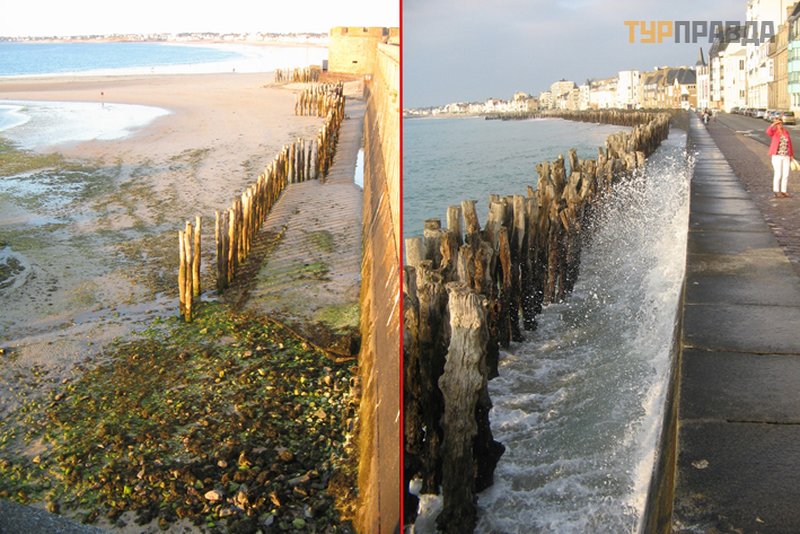
The current Great Saint-Malo traces its history back to ancient times.
The oldest part of it is the current Saint-Servan (formerly the Episcopal Alet). It was the seaport of one of the Celtic tribes at the mouth of the Rance (the Phoenicians came here, who went to Great Britain for tin). Then it was strengthened by the Romans who came to these parts. In the 6th century, the Welsh monk Mac'h Low (Maclou) arrived here. He preached in Armorica (the ancient name of Brittany), was the bishop of the town of Alet. By the XII century, Alet was destroyed by numerous raids from the north (Saxons, Franks, Normans) and weakened.
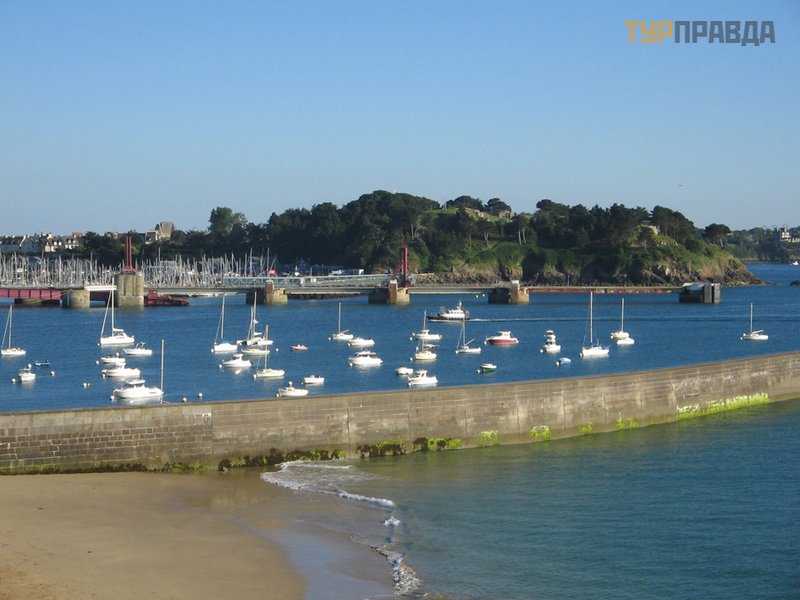 View of Saint-Servant (formerly Alet) from Saint-Malo
View of Saint-Servant (formerly Alet) from Saint-Malo
To the east, a new settlement has appeared on a neighboring island. It was named after one of the seven especially revered Breton saints - that same Welsh saint Malu. As belonging to the bishop of Saint-Malo, he had special privileges (those who fled from various kinds of authorities could find refuge in it).
At the beginning of the 14th century, city self-government arose, which would continue under the French kings. During these years, the city passed endlessly to the French kingdom, then the duchy of Breton until the final annexation of Brittany to France under Francis I. In the 16th century, the city declares its independence from the French kingdom - for four years it becomes the Republic of Saint-Malo. Jacques Cartier sails from here to Canada, where he explores the area of the St. Lawrence River and founds modern Montreal, donating vast lands to Francis I. In the 18th century, corsairs and adventurers-explorers Duguet-Truen, Surcouf and others (you, of course, know the difference between pirates and corsairs who robbed "in the royal service"? ) left Saint-Malo on their campaigns, further south to Cape Horn.
When the tide is low, you can walk overland to the islands of Grand Baie (with the grave of a native of Saint-Malo Chateaubriand) and Petit Baie.
By the way, the first tourists appeared here already in the middle of the 19th century, then travelers reached the writer's grave.
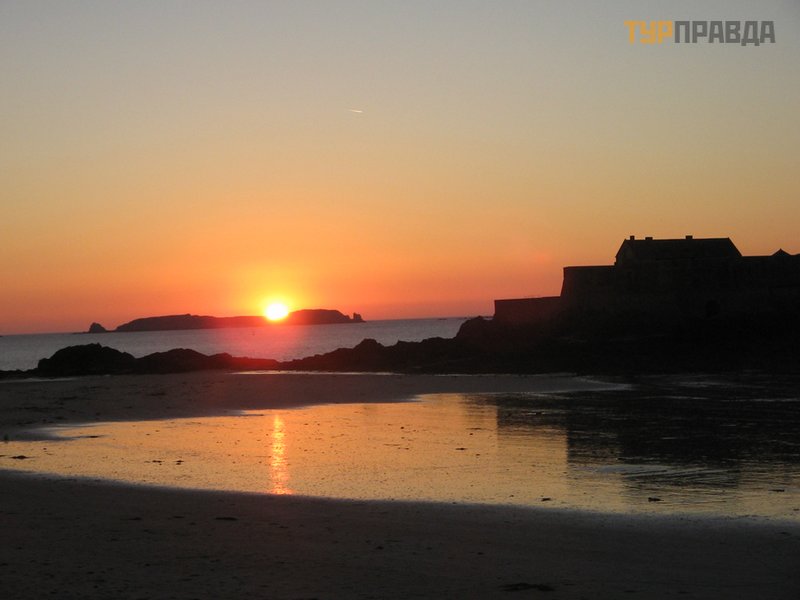 Greater and Petit Baie and Fort Nacional
Greater and Petit Baie and Fort Nacional
The old city «intra muros» (inside the walls) - one of Vauban's masterpieces - crowded inside the bastions . The walls stretch for almost 2 km. The medieval city was almost completely burned out in the 17th century. Only a few houses remain. It was then that Vauban and his assistants rebuilt it. Then the city was almost completely destroyed during the Second World War.
Walking along the walls of Saint-Malo.
If you climb the walls of the city at the gates of Saint-Vincennes and go left along the wall, then behind the gates of Saint-Louis on the corner there will be a monument to Duret-Trouin. On the right below is the corsair museum. And behind the walls is a monument to Bourdonnay. There are restaurants and cafes in the wall.
You need to exit through this gate if you want to get to Saint-Servant on foot along the sea, or visit Dinard by boat.
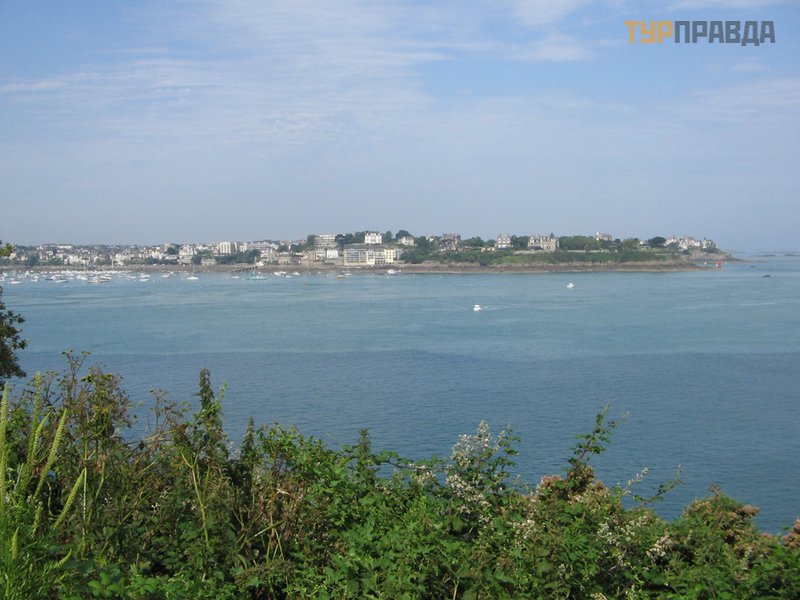 View of Dinard from Saint-Servant
View of Dinard from Saint-Servant
Ferries to the Channel Islands and further to Portsmouth (UK) depart from the isthmus between St. Malo and St. Servan. Not far in this part of the intra muros, the medieval arch Recolet, which remained after the fires, is thrown across the street of the Old Fortress Walls (not visible from the wall).
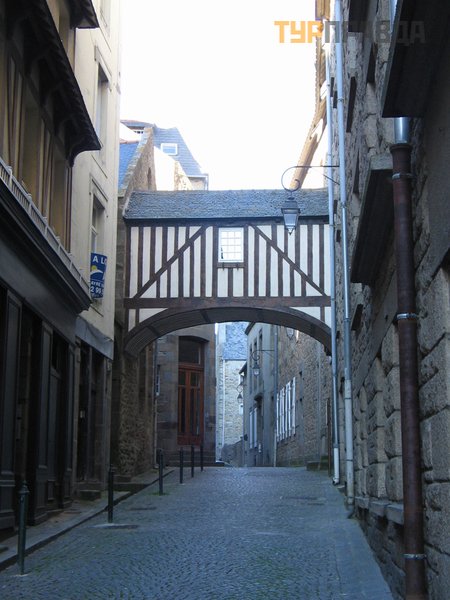
Then the wall turns. You need to exit through the Dinan gate if you want to go to Fort Latte, to the tide station, to Dinan along the Rance and to other places by water, because here is the ticket office of the Corsaire travel company organizing boat trips. There, on the board, you can find out the schedule for the coming days (I was sent here at the tourist office) or buy an excursion.
Then the wall turns along the English Channel.
There are wide beaches here, locals come here to watch the sunset. There is a monument to Cartier (Dutch Bastion), and then - Surcouf (Quebec Square).
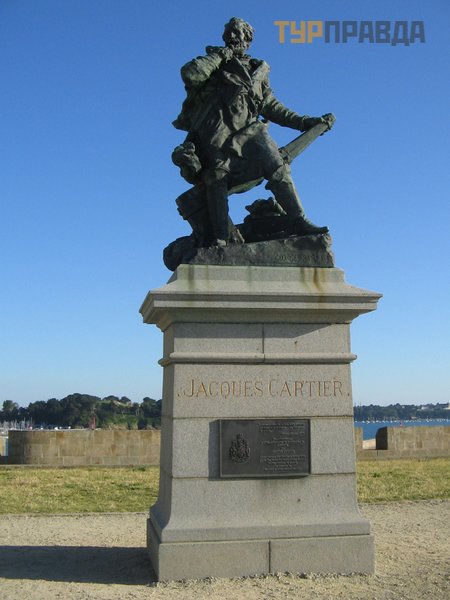 Monument to Jacques Cartier
Monument to Jacques Cartier
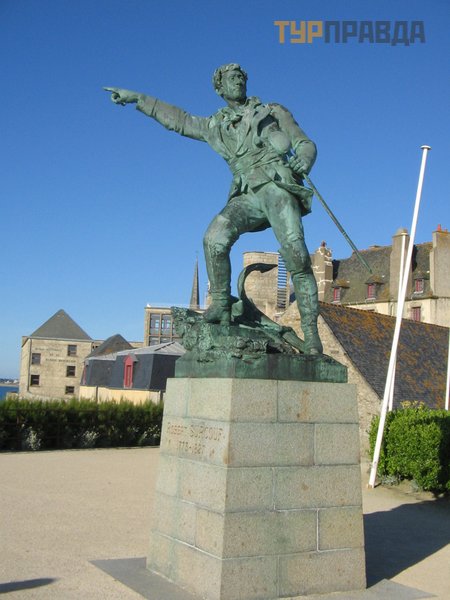 Monument to Robert Surcouf
Monument to Robert Surcouf
Here, right in the sea, a pool is organized: when the tide is low, sea water remains in it, at high tide, only a tower sticks out of the sea. Through the gates of this part of the wall you can get to the islands of Big and Small Be. Here, on the eastern bastion, plans are placed for the various forts of Vauban and the islands, indicating the distance to them.
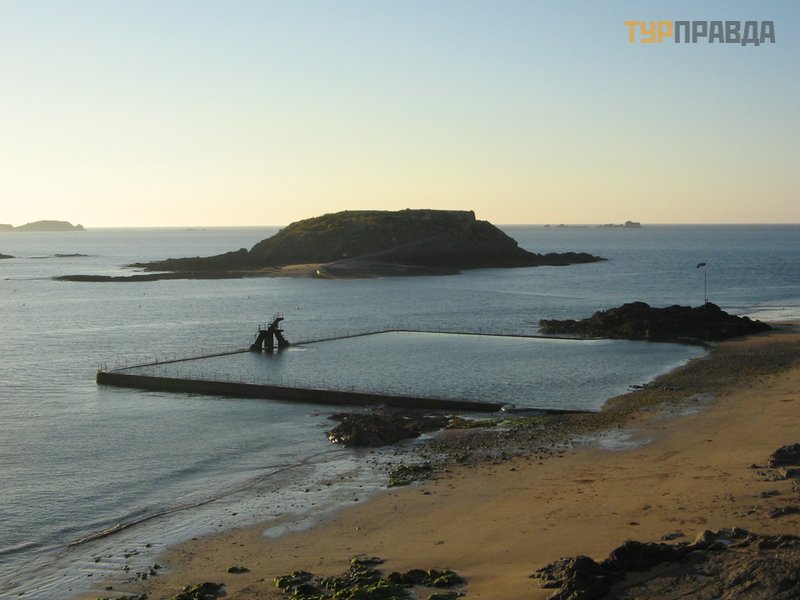 Channel Pool
Channel Pool
Further on, the wall turns towards the castle. In this part of intra muros there is a wooden house, preserved after the fire, on Pelicot street (not visible from the wall).
On the right below, already near the castle, there is the Chateaubriand hotel, Chateaubriand was once born in this house (a monument to him is located outside the wall near the castle).
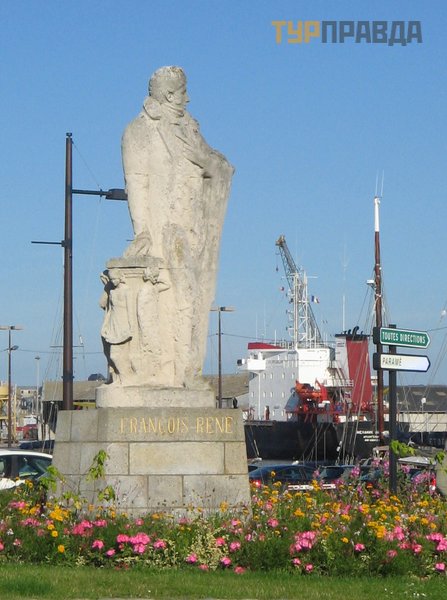 Monument to Chateaubriand
Monument to Chateaubriand
The part to the right of the Saint Vincennes Gate is the oldest part of the former Castle of the Dukes of Breton. It was built in opposition to the freedom-loving and obstinate city. The old castle consists of a donjon and four towers. The donjon was built under the Duke of Breton Jean V at the beginning of the 15th century (he was the son-in-law of the French king, who transferred the city of Brittany at that moment). Then Philip II (father of the last duchess of sovereign Brittany) built another tower. The rest was completed under his daughter Anne of Brittany, the former wife of two French kings, and in this capacity did a lot for her native Brittany. The outer walls were then reinforced in the 17th century during Vauban's rebuildings to withstand artillery strikes.
The castle is occupied by the city museum. The city hall is located in the part that was attached to the barracks. After the war, the castle was quickly restored.
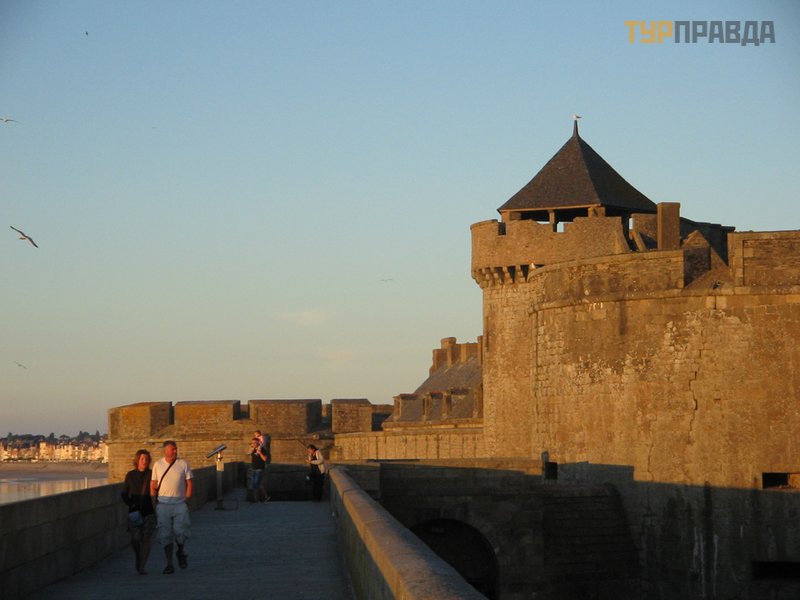 Castle of the Dukes of Breton
Castle of the Dukes of Breton
In the middle of the city rises the spire of the St. Vincent of Zaragoza Cathedral (XII-XVIII centuries), which was episcopal before the revolution (in the XII century, the bishop moved from Alet to the rapidly developing Saint-Malo). Built on the model of the cathedral in Angers, because they say that he is an example of the Angevin style. In order to enter the cathedral, you need to go down. The difference between the western entrance and the choirs is 2.5 meters. The oldest parts are the nave and the transept (Romanesque columns), and the remains of the cloister (outside, in the southwestern part) have also been preserved. The cathedral was rebuilt after the war in the 70s. The neo-Gothic spire, which was erected with the financial assistance of Napoleon III, was replaced during the restoration of the 20th century with a granite one according to old samples.
Cartier and Duguet-Truen (in the chapel of the northern part) are buried in the cathedral, and the tombstone of one of the first bishops was also found. The modern bronze altar has features of the Celtic style. The stained-glass windows are also from the 20th century and tell about the religious history of the city. The original of the Madonna and Child, which used to be on the Great Gate (XV century), was transferred to the cathedral. Since the Bretons are the most religious in France, tourists are sometimes not allowed to go inside (as indicated by a sign in front of the closed door).
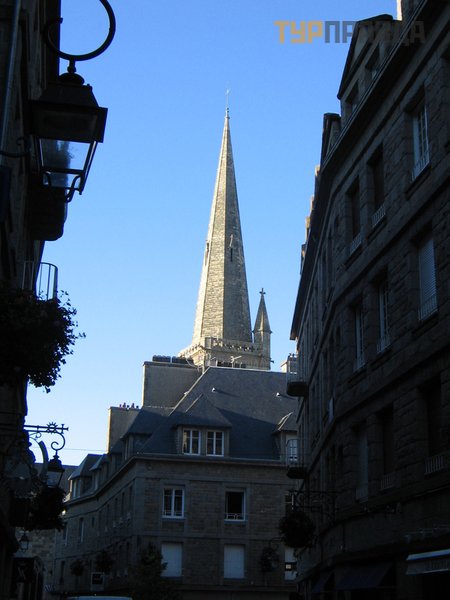 Saint Vincent of Zaragoza Cathedral
Saint Vincent of Zaragoza Cathedral
Since the 70s, the urban settlement of Saint-Malo has included several formerly separate areas: Saint-Servan, Parame, Rotheneuf.
In them you can visit: the museum of corsairs (intra muros), closed in December-January and on Mondays; corsair sailboat (modeled after an 18th-century frigate); Fort Vauban "Petit Be", inaccessible at high tide; Fort Vauban "Nacional", inaccessible at high tide, open from June to September and on holidays; a large aquarium where you can see the inhabitants of all the seas, 8 rooms contain sharks, 600 species of other fish and turtles, new exhibitions every year; small aquarium (intra muros near the castle); museum of one of the women's religious communities (Saint Servan); The world of shells (intra muros), open from February to November, except Mondays, in the afternoon; museum of new lands, open on Wednesday and Saturday; Museum of Sculpture in the Rocks of Fuere (Rotheneuf), open all year; Memorial 39/45, open from April to October, except Mondays (Saint Servan); museum of the history of the city (intra muros), open all year except Mondays; the Museum of the Long Road to Cape Horn in the Tower of Solidor (Saint Servan), open all year except Mondays; museum J.
Cartier, open all year except Sunday; tidal power station at Rance, open on schedule. In addition, within 30 km from Saint-Malo, you can visit mills, private houses of ship owners, a cider museum, a Breton resistance museum (but this is already with a car). And then - castles, menhirs... that Brittany, which I wanted to see...
Ruins of St. Peter's Basilica in Aleta. The first basilica was built in the 4th century. Then, in its place, in the 9th century, a single-nave church appeared, having a plan common in the Carolingian empire. Rebuilt in the 10th century during the reign of the Normans. It was the main episcopal cathedral before the relocation of the head of the church to Saint-Malo. Peter's Church was finally destroyed in the 13th century during a conflict over taxes with Saint-Malo.
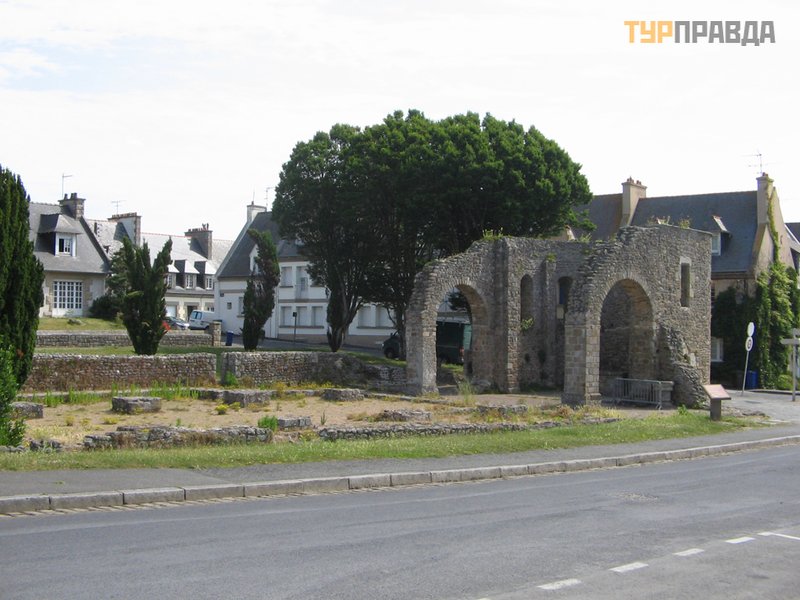 The ruins of the church of St. Peter in Alet (today's Saint-Servant)
The ruins of the church of St. Peter in Alet (today's Saint-Servant)
Solidor Tower. Translated from the Breton "gate of the river".
Built in the 14th century by the Duke of Breton, Jean IV, to control the mouth of the Rance at a time when Saint-Malo was once again in revolt. Oregle Castle already existed on this site, which, in turn, stood on the site of more Roman fortifications. In the 16th century, the Maluans besieged the fortress. Louis XIII ordered to restore the destroyed. Vauban included Solidor in the defensive system of Saint-Malo. This is not one tower, but three connected to each other. In the 18th century, the drawbridge was replaced by a permanent one. After the revolution, a prison was set up here.
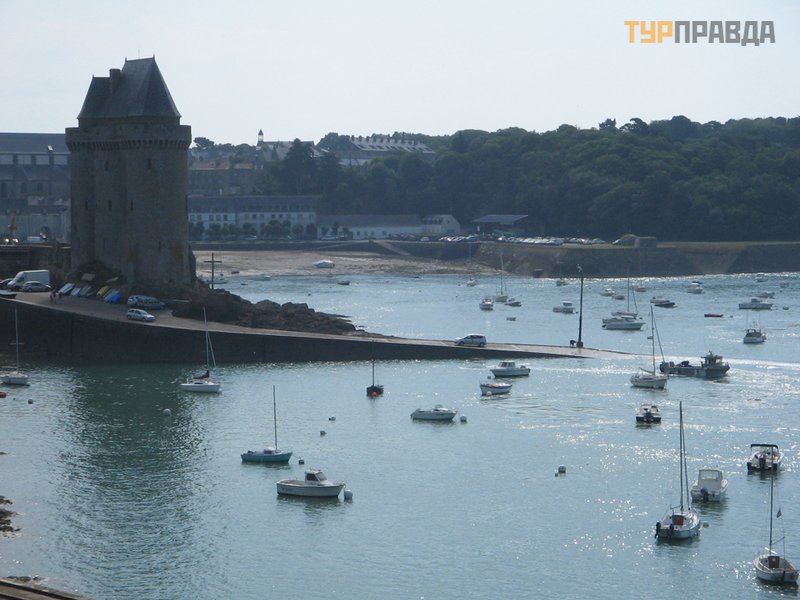 Solidor Tower in Saint-Servant
Solidor Tower in Saint-Servant
There are very impudent seagulls in Saint-Malo. I bought a pancake and cider to eat. What happened next was like Hitchcock's The Birds. These sassy birds just jumped on me, trying to snatch the Breton pancake with chestnut jam. The locals kept telling me: they are attacking you, hide the pancake. I didn't get to try the chestnut jam.















